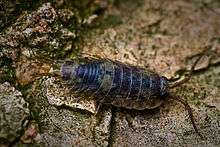Ligia oceanica
Ligia oceanica, the sea slater, common sea slater or sea roach, is a littoral woodlouse, living on rocky seashores of the european North Sea and Atlantic coastlines.
| Ligia oceanica | |
|---|---|
 | |
| Scientific classification | |
| Kingdom: | |
| Phylum: | |
| Subphylum: | |
| Class: | |
| Order: | |
| Family: | |
| Genus: | |
| Species: | L. oceanica |
| Binomial name | |
| Ligia oceanica | |
| Synonyms [1] | |
| |
L. oceanica is oval, twice as long as broad and may reach up to 30 millimetres (1.2 in) in length, making it one of the largest oniscid isopods.[2] Its colour may vary from grey to olive-green, and it has large compound eyes and long antennae, ⅔ as long as its body.[3]
L. oceanica is found in temperate waters from Norway to the Mediterranean Sea,[4] and from Cape Cod north to Maine.[5] It is a common species, occurring wherever the substrate of the littoral zone is rocky, and is especially common in crevices and rock pools and under stones.[3] It is a nocturnal omnivore,[6] eating many kinds of seaweed, diatoms[3] and debris, with a particular fondness for bladder wrack (Fucus vesiculosus).[2]
L. oceanica individuals live for 21⁄2–3 years and usually breed only once.[6]
Genome
The mitochondrial genome of L. oceanica was sequenced in 2006. It is a circular double-stranded DNA molecule, with a size of 15,289 base pairs. Although gene order is not conserved among isopods, L. oceanica shows a similarly derived gene order to Idotea balthica, compared to the arthropod ground pattern, but the positions of three tRNA genes differ in the two isopod species. [7]
References
- Helmut Schmalfuss (2003). "World catalog of terrestrial isopods (Isopoda: Oniscidea) — revised and updated version" (PDF). Stuttgarter Beiträge zur Naturkunde, Serie A. 654: 341 pp.
- "The Care of Woodlice (Crustacea, Isopoda, Oniscidae)". November 11, 2005.
- Susie Ballerstedt (2005). "Common sea slater - Ligia oceanica". Marine Life Information Network: Biology and Sensitivity Key Information Sub-programme. Archived from the original on May 15, 2011. Retrieved October 27, 2015.
- Juan Luis Menéndez (July 3, 2005). "Ligia oceanica (Linnaeus, 1767)" (in Spanish). Naturaleza Cantábrica.
- Richard Fox (2001). "Invertebrate zoology laboratory exercises". Lander University. Archived from the original on 2006-09-03.
- "Sea slater (Ligia oceanica)". ARKive.org. Archived from the original on 2006-05-17. Retrieved December 9, 2006.
- Kilpert, Fabian; Podsiadlowski, Lars (2006). "The complete mitochondrial genome of the common sea slater, Ligia oceanica (Crustacea, Isopoda) bears a novel gene order and unusual control region features". BMC Genomics. 7: 241. doi:10.1186/1471-2164-7-241. PMID 16987408.
External links


- Photos of Ligia oceanica on Sealife Collection